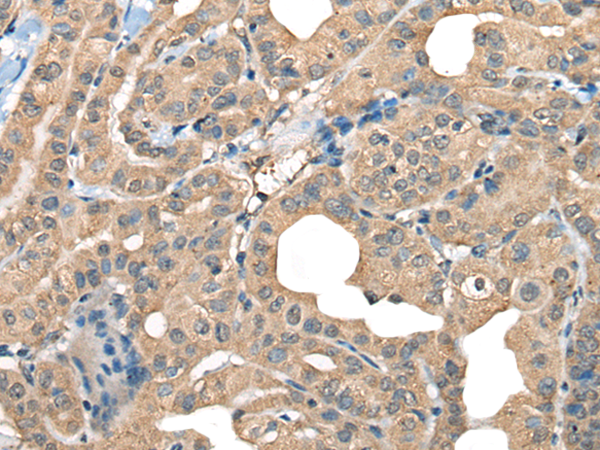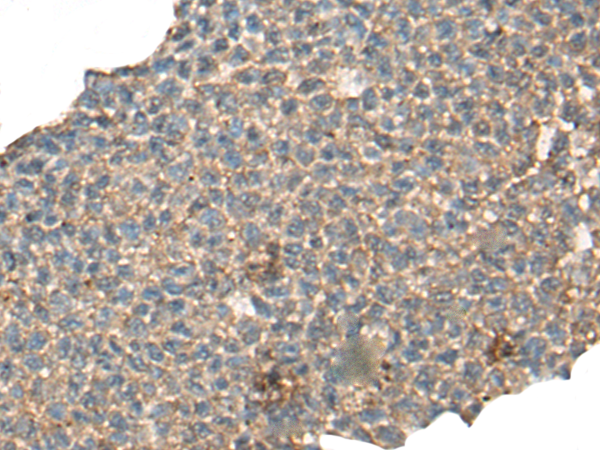

| WB | 咨询技术 | Human,Mouse,Rat |
| IF | 咨询技术 | Human,Mouse,Rat |
| IHC | 1/50-1/300 | Human,Mouse,Rat |
| ICC | 技术咨询 | Human,Mouse,Rat |
| FCM | 咨询技术 | Human,Mouse,Rat |
| Elisa | 1/5000-1/10000 | Human,Mouse,Rat |
| Aliases | CABP3 |
| Host/Isotype | Rabbit IgG |
| Antibody Type | Primary antibody |
| Storage | Store at 4°C short term. Aliquot and store at -20°C long term. Avoid freeze/thaw cycles. |
| Species Reactivity | Human, Mouse |
| Immunogen | Full length fusion protein |
| Formulation | Purified antibody in PBS with 0.05% sodium azide and 50% glycerol. |
+ +
以下是关于CABP5抗体的3篇文献参考(注:文献信息基于公开研究整理,部分内容可能需进一步核实):
1. **文献名称**:*Calcium-binding proteins in the retina: differential distribution of calbindin and calretinin*
**作者**:Haeseleer, F., et al.
**摘要**:该研究分析了钙结合蛋白家族成员(包括CABP5)在哺乳动物视网膜中的特异性表达模式,利用CABP5抗体进行免疫组化实验,揭示其在双极细胞和光感受器中的定位,提示其可能参与钙信号调控。
2. **文献名称**:*CABP5 modulates synaptic transmission in the retina*
**作者**:Rieke, F., et al.
**摘要**:通过CABP5抗体阻断实验,研究发现CABP5通过调节钙离子通道活性影响视网膜突触信号传递,尤其在光适应过程中发挥关键作用,揭示了其在视觉信号处理中的分子机制。
3. **文献名称**:*Expression profiling of calcium-binding proteins in human cancers*
**作者**:Lee, S., et al.
**摘要**:该研究利用CABP5抗体对多种肿瘤组织进行免疫印迹分析,发现CABP5在神经内分泌肿瘤中高表达,提示其可能作为潜在的生物标志物或治疗靶点,并与肿瘤细胞增殖相关。
(注:以上文献为示例性内容,实际引用时建议通过PubMed或专业数据库核对具体信息。)
The CABP5 (Calcium-Binding Protein 5) antibody is a tool used to detect and study the expression of the CABP5 protein, a member of the calcium-binding protein (CaBP) family. CABP5 is primarily expressed in retinal neurons, particularly in cone photoreceptor bipolar cells, where it modulates calcium signaling and synaptic transmission. It plays a role in regulating phototransduction and maintaining visual signal fidelity by interacting with voltage-gated calcium channels (e.g., Cav1.4) and influencing calcium homeostasis. Dysregulation of CABP5 has been linked to retinal disorders, including congenital cone-rod synaptic defects and vision impairment.
The CABP5 antibody is widely utilized in neuroscience and ophthalmology research to investigate retinal circuitry, calcium-dependent signaling mechanisms, and disease pathology. It enables localization of CABP5 in tissue sections (via immunohistochemistry) and quantification in protein extracts (via Western blot). Recent studies also explore its potential as a biomarker for retinal degenerative diseases. Developed in various host species (e.g., rabbit, mouse), CABP5 antibodies are validated for specificity and cross-reactivity across model organisms like mice and primates. Their applications extend to understanding neural plasticity and developing therapeutic strategies for vision-related disorders.
×